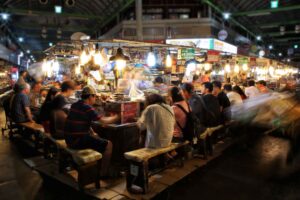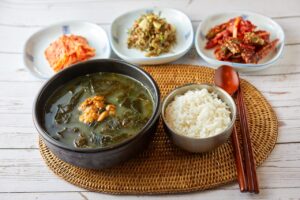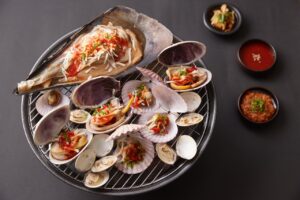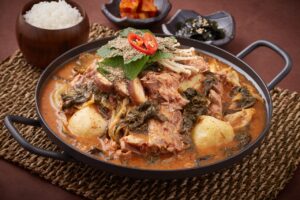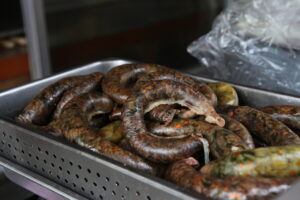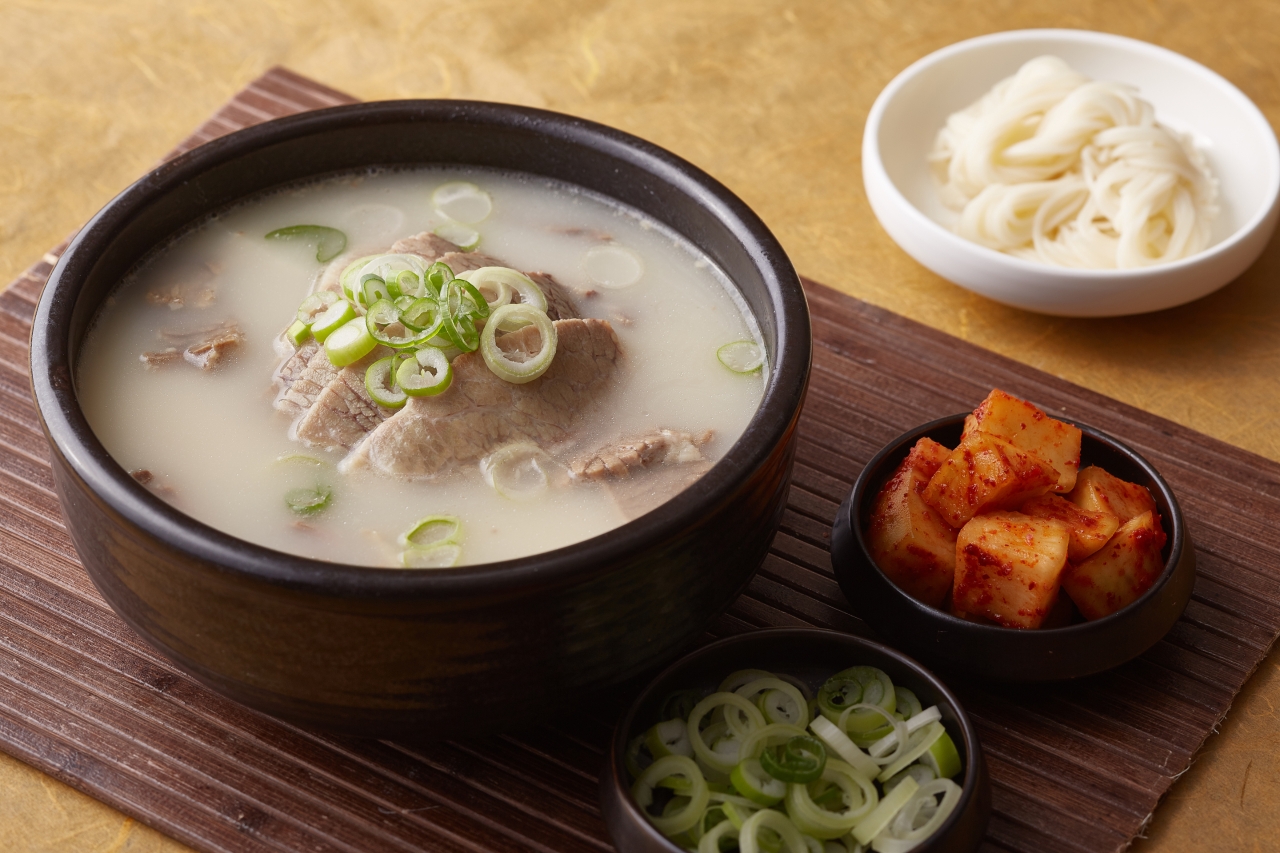
seolleongtang with kkakdugi ⓒ한국관광공사 사진갤러리- 디그램
Seolleongtang, A Bowl of Korean Comfort.
Introduction:
When it comes to comfort food, few dishes can rival the soothing, nourishing qualities of Korean Seolleongtang. This unassuming bowl of soup holds a special place in the hearts of Koreans, offering a taste of tradition, warmth, and culinary heritage.
The Simmering Craft:
At its heart, Seolleongtang is a humble dish crafted from beef bones, patiently simmered for hours. The magic happens as the bones release their essence into the broth, creating a velvety, milky elixir. Leg bones and ox tail are the stars of this show, their marrow and collagen infusing the soup with richness and depth.
A Symphony of Simplicity:
Seolleongtang’s beauty lies in its simplicity. The broth is mild, almost ethereal, with a gentle sweetness from the bones. It’s seasoned with a touch of salt, allowing the natural flavors to shine. Yet, it’s a canvas for customization – diners often personalize their bowls with garlic, scallions, salt, and black pepper.
The Noodle Connection:
While Seolleongtang is a satisfying soup on its own, it often finds companionship in noodles. Somyeon (thin wheat noodles) or kalguksu (knife-cut noodles) gracefully join the broth, turning a bowl into a complete meal.
The Healing Elixir:
Beyond its taste, Seolleongtang is renowned for its potential health benefits. Collagen-rich and nutrient-packed, it’s a go-to choice when people need nourishment or are recovering from illness.
A Taste of Tradition:
Seolleongtang isn’t just a meal; it’s a vessel for tradition and family. It’s the steamy bowl that brings generations together, evoking cherished memories of cozy gatherings and shared stories.
Conclusion:
So, if you’re seeking comfort in a bowl, consider Seolleongtang. It’s more than a dish; it’s a warm embrace, a connection to the past, and a reminder of the simple joys that food can bring.
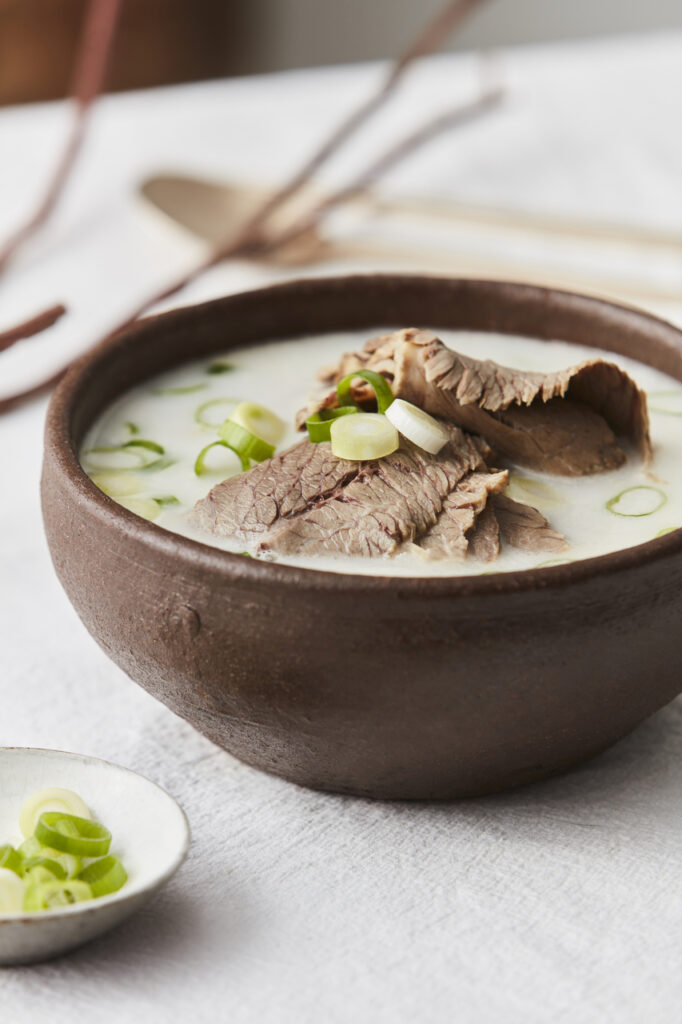
History of Seolleongtang
Seolleongtang, a beloved Korean soup, has a rich history that spans centuries and is deeply rooted in Korean culture. Here’s a brief overview of the history of Seolleongtang:
Ancient Origins: The origins of Seolleongtang can be traced back to ancient Korea, where it was initially referred to as “seolratang” during the Goryeo Dynasty (918–1392) and “sollongtang” during the Joseon Dynasty (1392–1897). This soup was created as a way to utilize every part of the animal, especially during times when resources were scarce. The use of beef bones, particularly leg bones and ox tail, was common in Korean cuisine, and Seolleongtang emerged as a way to maximize their nutritional value.
Simple and Humble Beginnings: Seolleongtang was originally a simple and humble dish made by simmering beef bones for an extended period. This allowed the bones to release their marrow, collagen, and nutrients into the broth, creating a nourishing and hearty soup. In the past, it was often consumed by laborers and commoners as an affordable source of sustenance.
Culinary Evolution: Over time, Seolleongtang evolved, incorporating additional ingredients and variations to enhance its flavor. While the basic recipe remained true to its roots, variations began to appear, with different regions of Korea adding their own unique twists and ingredients to the soup.
Cultural Significance: Seolleongtang holds a special place in Korean culture as a comforting and restorative food. It is often enjoyed during cold winters or when individuals are feeling weak or unwell. Many Koreans have fond memories of enjoying Seolleongtang with family and friends, often garnishing it with their preferred seasonings and condiments.
Modern Adaptations: In modern times, Seolleongtang is still widely enjoyed in Korea and has also gained popularity internationally as Korean cuisine becomes more recognized worldwide. It is appreciated not only for its taste but also for its potential health benefits, particularly due to the collagen-rich broth.
Today, Seolleongtang remains a symbol of Korean culinary heritage, offering a glimpse into the simple and nourishing dishes that have sustained generations of Koreans. Whether served in traditional restaurants or enjoyed as street food, Seolleongtang continues to provide comfort and a connection to Korea’s culinary past.
Key Features
- Ingredients: The primary ingredients for seolleongtang are beef bones, including leg bones and ox tail, as well as brisket or other beef cuts. These bones are boiled for hours to create a rich, milky broth.
- Simmering: The hallmark of seolleongtang is the lengthy simmering process, often lasting several hours or even overnight. This extended cooking time allows the bones to release their marrow, collagen, and minerals into the broth, resulting in a creamy and flavorful soup.
- Mild Flavor: Seolleongtang has a mild and slightly milky flavor, with a hint of natural sweetness from the bones. It’s typically seasoned with salt and sometimes served with additional condiments and seasonings.
- Toppings and Condiments: Seolleongtang is often served with various accompaniments, including finely sliced scallions, minced garlic, salt, black pepper, and sometimes kimchi or spicy condiments. Diners can customize their soup to taste by adding these condiments.
- Noodles: While seolleongtang can be enjoyed as a soup on its own, it’s also common to serve it with noodles. The addition of noodles turns it into a heartier meal. The noodles used can vary but are often wheat-based noodles like somyeon (thin wheat noodles) or kalguksu (knife-cut noodles).
- Banchan: Seolleongtang is typically served with banchan, which are small side dishes that complement the meal. Common banchan include kimchi, pickled vegetables, and radish kimchi.
- Health Benefits: Seolleongtang is valued for its potential health benefits due to the nutrients and collagen-rich broth it provides. It’s often consumed when people are feeling weak or recovering from illness.
Cooking Method
Ingredients:
- 2-3 pounds of beef leg bones (such as marrow bones)
- 1 pound of beef brisket or other beef cuts
- 2-3 pieces of ox tail (optional)
- 10 cups of water
- 1 large onion, peeled and halved
- 8-10 cloves of garlic, peeled
- 1-2 slices of ginger (optional)
- Salt to taste
- Cooked noodles (such as somyeon or kalguksu, optional)
- Chopped green onions for garnish
- Optional condiments: minced garlic, salt, black pepper, and chili paste (gochugaru)
Instructions:
- Prepare the Bones: Start by blanching the beef leg bones and ox tail (if using) in boiling water for about 5-10 minutes. This step helps remove impurities and excess fat. After blanching, rinse the bones thoroughly under cold running water.
- First Simmer: Place the rinsed bones, beef brisket, and ox tail (if using) into a large stockpot or a Korean earthenware pot (dolsot). Add the water and bring it to a boil. Skim off any foam or impurities that rise to the surface.
- Reduce Heat and Simmer: Once the water comes to a boil and has been skimmed, reduce the heat to low, cover the pot, and let it simmer gently for several hours. Traditionally, Seolleongtang is simmered for at least 4-6 hours, and some prefer an even longer simmer for deeper flavor. Keep an eye on the water level; you may need to add more water during the simmering process to keep the broth from drying out.
- Second Simmer: After several hours of simmering, remove the beef brisket and any other ingredients from the pot. Strain the broth to remove any solids, returning the clear broth to the pot.
- Beef Slicing: Slice the beef brisket thinly and set it aside. You can also shred the meat for serving.
- Onion and Garlic: Add the halved onion, peeled garlic cloves, and ginger (if using) to the pot with the broth. Continue to simmer for an additional 1-2 hours, allowing the flavors to meld.
- Season: Season the broth with salt to taste. The amount of salt needed may vary, so start with a small amount and adjust as necessary.
- Final Touch: Remove the onion and ginger slices from the broth. You can leave the garlic cloves or remove them, depending on your preference.
- Serving: To serve Seolleongtang, place cooked noodles in individual bowls, add some of the sliced beef, and then ladle the hot broth over them. Garnish with chopped green onions. You can also serve minced garlic, salt, black pepper, and chili paste as condiments for diners to customize their soup.
- Enjoy: Seolleongtang is best enjoyed piping hot. Mix in the condiments to taste, and savor the rich, comforting flavors of this traditional Korean soup.
Please note that making Seolleongtang requires a significant amount of cooking time, so it’s a dish often prepared on weekends or special occasions when you have the time to let it simmer to perfection. The result is a hearty and satisfying Korean beef bone soup that’s both nourishing and delicious.
Recommend to Read >> Jjajangmyeon, Korean Black Noodle Aug, 2023.
